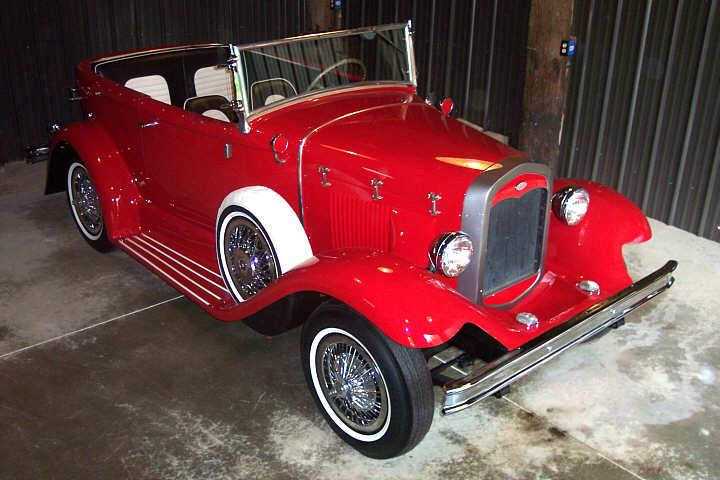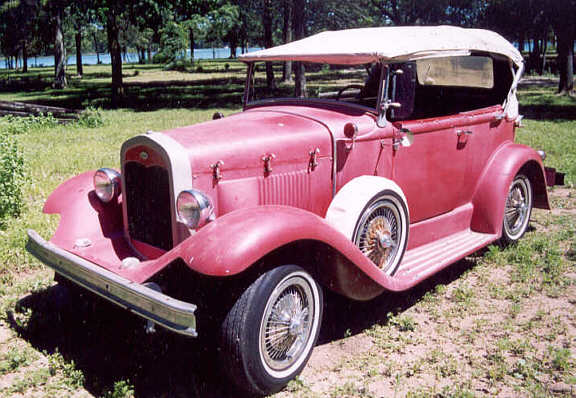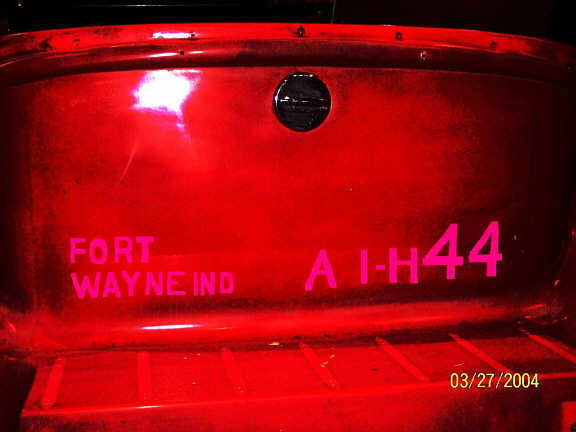The original Glassic Prototype (Scroll all the way down for pictures after restoration.) The story below was sent
to the Annex by Rex Kirkinburg and was posted on
6/14/2004. Thanks to Rex for his diligent efforts to learn about his car and for his willingness to share. |
| The following is the "brief" history of a
yearlong search to identify my newly purchased Glassic
Phaeton car as the original prototype. History of the prototype: Construction of the Prototype was started in 1963 in Fort Lauderdale Fla. Upon completion; International Harvester requested that the prototype be brought to their facility in Fort Wayne, Indiana for evaluation. They wanted assurance that the car met their approval before agreeing to allow the use of their Scout chassis for the Glassic. Jack Faircloth took the prototype to Fort Wayne where engineers evaluated the car and made eight or nine improvement suggestions. All the improvements were applied to their process along with approx. a dozen improvements that the Faircloth team had made. The story of the long search to verify this Glassic as being the original prototype car. It all began on July 19th, 2003. As I was driving home from work, I saw the car parked in a residential yard with a for sale sign in the window. I had been looking for a car to start a street rod project and this one seemed to have potential. While negotiating the price with the owner, he stated that the rumor that came with the car was that it was a prototype car.
My thoughts were "I’ve heard this sales pitch before." Regardless, we struck a deal and I drove the car home. Once home, I went to the computer to see what information I could find on Glassics. The Glassic Annex came up and was filled with information. I spent many nights reading everything I could find on the history of the Glassic. The first few clues that made me start wondering if the "prototype sales pitch" might just have some merit came when I began going through the documentation I received with the car. The first thing that sparked my attention was that the title showed the car as a 1963 I.H. This is the year that Jack Faircloth started building the prototype car. Another document stated that the car was purchased by the 1st owners, (a car dealership in Mich.) in Fort Lauderdale Florida. Fort Lauderdale is where the prototype was built, and then production moved to West Palm Beach. With these three clues (rumor with the car, date on title, & purchase location being Fort Lauderdale) I decided against chopping the car up to build a street rod and do some further investigating. Even though all indicators stated that originality doesn’t necessarily gain any value to the car, I was fascinated with the history of the Glassic and decided I would keep it as original as possible. The information I had so far on the car was interesting, although I needed more concrete evidence before I could claim the car was the prototype car. The first obvious step was to contact the owners of the car dealership located here in Michigan. They bought the car in Fort Lauderdale in 1966 and it sat in their showroom for approx 25 to 30 years. This first lead came to an end after learning both husband & wife were deceased. One evening, as I was looking at car#101 (the 1st production car) on the Glassic Annex web site, an idea popped in my head. The thought was as follows: If I could find out the motor number of car #101 and compare it to my motor number, that would tell me sequentially if my motor was built prior to the first production car. If so, I felt that would verify that my car was truly the prototype. So, I e-mailed the owners of car#101 and asked if they would send me the motor number from their car. Weeks went by with no response. In the meantime, I was researching anything I could on the web and old International Scout manuals for information regarding motor serial numbers. I finally came across a web site that advertised a Scout 80 4 cyl. Motor that was built in mid 1962. That serial number was 58,280. My serial number was 52,320, which meant it was built early to mid 1962. In my mind, my Glassic had to be the prototype car based on the year the engine was built. At this same time, I saw on the Glassic Annex web site that car #101 was for sale. I was interested in purchasing the car, although I had no idea how I could arrange the purchase with my work obligations and the distance involved. I also knew it may be my last chance to get the motor number off that car. So, I e-mailed the owners of car #101 again. This time I got a response, Although they did not send the motor number (Jess tried but never located it), they identified themselves as Jess & Elizabeth Taylor. Elizabeth stated she was the sister Joel Faircloth and gave me Joel’s e-mail address. Joel is the son of Jack Faircloth (the founder of the Glassic car). What a lucky break!! I knew Joel would be a wealth of information and I also knew that if I could get Joel’s confirmation that the Glassic I was in possession of was the prototype, it would finally end my long search. In my first E-mail to Joel, I described the car and told him about being titled a 1963 I.H. I told Joel about the rumors of the car being the prototype and about it being purchased in Fort Lauderdale in 1966 then brought to Michigan. I sent the E-mail and patiently waited his response. Joel’s response came the next day. The E-mail response was loaded with information of Glassic history, although no mention of recognition that I had the original Glassic prototype. (Understandable with no substantial proof with what I had sent to him.) So, it was back to more research. I followed up on some information that Joel had provided me in his E-mail. Although nothing concrete developed, the information provided many new clues. Eventually I came across a web site advertising an International Scout 80 series engine for sale. As I indicated earlier, the engine was built in mid 1962 with a serial # of 58,280. My Glassic serial # is 52,320 which means it was also built in early to mid 1962. (I found documentation of build dates on an International Scout web site) In my mind, this had to confirm that my Glassic was the prototype. How would a Glassic with a 1962 built motor, end up in a production built Glassic, since production started in 1966?? The first prototype was built on a used scout 80 chassis. Production chassis were sent new from International Harvester in Fort Wayne, and were 1966 and later. So, I fired off another E-mail to Joel with this new information in hopes his return message would "have his blessing" that the prototype had been located. Much to my dismay, Joel’s return E-mail contained no such confirmation. He shared even more history and did say "you may have a treasure", but no blessing. Disheartened, I was ready to give up. Knowing all the records of the Glassic business had been destroyed with water damage, I felt it was highly probable I would never be able to positively say I had the original prototype. Nine months of intensive research and I still could not positively say the car was the prototype. My last attempt was to run a title search on the car. The results took approximately 6 weeks. When the records came in, it showed only 3 previous owners. Myself, the person I purchased the car from, and the car dealership. All information I already knew. Then, in late March, 2003 I took the car to my neighbor, Dave Saffran, to be painted. Dave is an automotive paint rep. for Sherman Williams and an excellent restoration/painter. The Glassic was in Dave’s garage and we were looking it over trying to decide the scope of work needed to bring the car back to its original beauty. It was warm in the building, so Dave partially opened the large overhead door to allow some fresh air in. As we were walking back to the Glassic, we noticed something rather unusual about the car that had not been previously observed. The daylight shining through the partially opened door was revealing some letters imprinted across the back of the Glassic.
Markings barely visible
Markings touched up to be seen more easily The writing was very faint, and at first all we could make out was two large A’s on the right side. It was obvious there was more writing present, although we couldn’t make it out. Dave suggested we lightly buff the area to see if it would enhance the writing enough to make it legible. I was hesitant, then agreed. What was revealed after buffing was, in my mind, "almost spiritual, like the writing on the wall" Across the entire rear of the Glassic was written: "Fort Wayne, Ind. _ _ I.H. AA." I let out a shout that damn near raised the roof on Dave’s building. I knew then I had the proof I needed to show this Glassic is the original prototype. That evening, I E-mailed Joel with the story and attached pictures of the rear of the Glassic. His return E-mail was the blessing I had been searching nine months for. The first sentence read as follows: "Rex – You have certainly done your homework!!! Congratulations… Just to clear the air, you don’t have one of the prototypes: You have the only prototype we built." - " The Grand daddy of them all"
|
 As the lengthy and costly restoration process nears completion in the summer of 2004. |
 The original prototype car for Glassics, after restoration in 2004 |
| September, 2019. The word was received that this car is for sale. Here is a pic. of a window sign of the sale. Click the picture for a larger view. |



